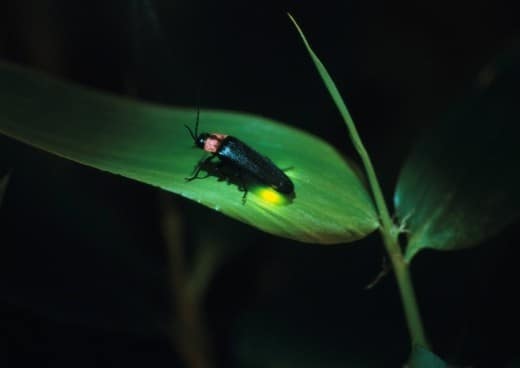What Do Fireflies Eat? | All About Fireflies
Ever wonder “What do fireflies eat?” or “Why do fireflies glow?” Well, wonder no more! Here are all the enlightening answers.

Coffee By Design | Portland, Maine
Photo Credit : Katherine KeenanThink back to those warm summer nights you spent in New England when you were a child. If you were anything like me, you devoted at least a few of those evenings to chasing fireflies around your backyard, glass jar in hand. For a lot of people, the blinking lights of fireflies are just as much a part of the classic summer nighttime scene as the chirping of crickets, the calling of katydids, or the buzzing of mosquitoes (as much as we wish that last one wasn’t). Most of us have probably only crossed paths with fireflies during the evening hours, when our lives briefly overlap, but this means that the rest of a firefly’s life, despite it being among the most famous and well-liked insects, is largely shrouded in mystery. So when fireflies aren’t flying around and showing off their luminance, what are they doing? Where do they go during the day? What do fireflies eat? What do they even look like when they’re not a blinking yellow-green light?
Below, you’ll find the enlightening answers to all of these common firefly questions.
What Are Fireflies?
Fireflies (or “lightning bugs”) are a family of beetles known for their ability to produce light. Through the use of specialized organs in their abdomens, they’re able to set off chemical reactions that result in a blinking or glowing light. This process is commonly known as bioluminescence and can be found in anything from fish to fungi.
Some fireflies blink their lights on and off in fancy patterns, others just emit a steady glow, and some can’t do either of those things. In fact, despite their common name, many firefly species are unable to produce any light at all.
Why Do Fireflies Light Up?
The reason why only some fireflies light up all comes down to—like most things in life—attracting a mate. Some species of fireflies evolved to use blinking or glowing lights to find a breeding partner, while others evolved to use invisible chemical signals (pheromones) instead. For the light-up species, the male will fly around and blink his lights in a certain, species-specific pattern—like a love song in Morse code. He’s trying to catch the eye of a female firefly, who he hopes will blink her own light in response from somewhere nearby.
When most people encounter them, fireflies are fully-grown, flying beetles, but they begin life in quite a different state. They start out as eggs in the ground and then quickly grow into larvae (sometimes called glowworms), which can spend up to several years underground. In the spring, the larvae turn into pupae and, subsequently, adult beetles.
Unlike their mature counterparts, all firefly larvae have the ability to glow. However, the larvae’s glowing doesn’t serve the same purpose that it does in adults: in larvae, glowing is instead used as a warning for predators. Hungry animals that eat a firefly larva soon come to regret their meal—a special chemical found in most firefly blood gives off a very foul taste. Predators learn to associate this bad taste with the firefly’s luminance and next time look elsewhere for a quick bite to eat.
What Do Fireflies Eat?
In their larval stage, fireflies are carnivorous. They eat soft-bodied insects that live on or in the ground, like snails, slugs, worms, or other larvae.
As they mature and turn into beetles, they do one of several things, depending on which species of firefly they are. Some fireflies eat the nectar or pollen of flowers, others eat smaller fireflies, and some don’t eat anything at all. This is due to the adult firefly’s relatively short lifespan, which is typically no more than a few months long and is normally spent looking for a mate.
Fireflies of the genus Photuris are especially devious when it comes to feeding. Females will lure in males of other species by mimicking their blinking patterns, so the hapless males fly over to the females in hopes of procreation, but are instead greeted by predation. This behavior has earned these particular lightning bugs the nickname “femme fatale fireflies.”
Where Do Fireflies Go During the Day?
Although most fireflies come out only at night, many species are active exclusively during the day. These species spend the daylight hours breeding and eating, while their nocturnal counterparts rest in fields or wooded areas until after dusk. Due to the brightness of the sun during the day, most diurnal fireflies have abandoned the ability to glow and instead use pheromones to attract their mates.
How Common Are Fireflies?
If you feel like you’ve been seeing fewer and fewer fireflies over the years, you’re not alone. They were once a very common sight throughout New England, but today, they’re more difficult to find. It’s hard to say for sure what has caused this decrease in the firefly population, but experts theorize that it could be due to pesticide use, habitat loss, or light pollution.
Hopefully, your most pressing firefly questions have now been answered. With your new-found appreciation for these glowing insects, you may be interested in signing up for Mass Audubon’s Firefly Watch Citizen Science Project. The program allows you to report your own firefly sightings online, which helps scientists track firefly populations across New England and hopefully determine the cause of their troubling decline.
Did you ever wonder “What do fireflies eat?” or “Why do fireflies glow?” Let us know!
This post was first published in 2016 and has been updated.








Loved this article – answered many of my childhood questions and yes – we still have many lightening bugs here near Cambridge, NY.
Hi Kelly,
I’m glad to hear that they’re still out there somewhere!
Great article bring gs back good times in Mass.
Truly enjoyed this article on fireflies. I remember how we enjoyed chasing fireflies when we were young. I believe pesticides have damaged many things of nature. I am thankful I grew up when life with nature was still enjoyed.
I do receive the Yankee magazine.
A rite of passage for youngsters in New England or for other areas east of the Mississippi River. I experienced both, now live out West and if we have them, they don’t blink, glow or probably exist. Different climate and flora. I expect that all the bug sprays, pest controls, artificial irrigation, those in ground sprinkler systems have had their share in eliminating this delightful aspect of summer. Magic in a summer garden in the early evening.
The magic of nature, on a summers eve !!!
If you’re curious to know more about these magical creatures, you might be interested in my new book, Silent Sparks: The Wondrous World of Fireflies.
P.S. The femmes fatales fireflies belong to the Photuris (not Photinus) group of fireflies – I know, it’s confusing!
Hi Sara,
Thanks for catching that!
live in bangor , me and have a large hay field in my back yard with lots of lighting bugs in summer and love them.
I am at lower Burrell a part of America and there’s no fireflys at our backyard still there used to be fireflies in our backyard
Loved catching lightning bugs when I was young! We put them in a glass jar, lined with grass, and had holes poked in the top. RULE of household: all lightning bugs had to be set free before our bedtime! I lived in rural, northern NH then. I live on NH’s sea coast now, and can’t recall the last time I saw one of these divine wonders. 🙁
Wonderful article enjoyed it very much. Live in a mid size town in middle Tennessee and yes we have lightening bugs (as they are known here).
Yes as a kid from Chicopee Ma we saw lightening bugs. I now live in the Niagara Pininsula of Ontario right on Lake Ontario. We have several acres of forested land behind our house and nothing is more exciting than standing on the porch in the summer with my grandchildren and watching fireflies. A small miracle of nature.
We still have fireflies just about every year in Freetown Massachusetts albeit some years less so. The most dramatic sighting for our family was on a trip to Strasburg Pennsylvania a number of years ago when the whole town seemed aglow. Looking across the vast farmed fields of the Amish was a sight that even Disney could not duplicate.There must have been millions if not billions of one of nature’s wonders. However, many met their demise because of their encounter with motor vehicles. They were everywhere, and I mean everywhere. I think that we will never see such a spectacle again, but I hope we will.
We live in Wildwood, MO about 40 miles west of St. Louis, in a rural setting. The view of the woods across from our house this evening reminds us of Christmas! The fireflies are especially active this year. When we we built our house here (19 years ago), they were everywhere! About 2 years into our residence an abundance of mosquitos led to a city wide spraying of malathion. Sadly, it took its toll on our firefly population, as well. We are happy to see the return of our glowy friends!
Just yesterday I asked my husband if he had spotted any fireflies and the answer was the same as mine, none thus far. We live in China, ME and have lots of land surrounding our home and usually the field is lite up by this time of the year with the lovely glow of these critters. This usually begins in early June but this year nothing. Could it be the cold and snowy winter we encountered could have made their arrival later? Just worried I won’t see them at all this year.
I think that cold snaps thin out the population plus since some of the larvae spend years in the ground there are bound to be some seasons with more or less due to the timing of their maturation.
I live in central Illinois and am happy to report that the fireflies are more than abundant here. You can look out in yards and fields and often see thousands at a time. Last year they were not quite as numerous… I’m sure it had something to do with the timing of the maturation of the different generations of larvae into adults rather than some mythical man made cause. I rather think that’s the reason why some other areas periodically don’t see as many as well. These cycles have existed for centuries. Same thing with cicadas/etc.
I live in Oregon and I have never seen a firefly here — can you explain why we don’t seem to have them here?
I’m in Washington, MO, just west of St. Louis, far enough away from the night lights. The lightning bugs are abundant this year! I’ve made myself late going to bed because I stand on my deck just watching the “magic” in the night woods!
I live in eastern PA and grew up catching lightning bugs. There aren’t as many as there were back then, but that could be because of my new location. It seems to me that as the nights got hotter and stickier, the more fireflies we’d see. The same applies to the mosquitoes. The best nights for fireflies was also the itchiness. They seemed to show up after school ended in June and by August they were gone. They’ll always be a happy memory of my childhood, after all, I never heard any summertime horror stories involving fireflies.
I live in northern North Carolina and see fireflies in the warm summer months at dusk out here among the trees and cornfields. There is little to no light pollution, so these beetles don’t have competition. I hike and search for bugs and often find adult fireflies resting on leaves. I assume that they are waiting for the evening to come so they can find a mate, though maybe they are also active in the daytime using pheremones (I wouldn’t know). I haven’t seen any mating in my daytime bug quests (though I’ve found plenty of other insects mating on the leaves).
I live in Vietnam . I enjoyed and studied about fireflies. I am planning to raise fireflies in my hometown. Firefly in my hometown is a symbol of love, so many young people love it . I’m researching and feeding fireflies. Hope to get more from everyone.
Grew up in southeastern NH and enjoyed fireflies every summer. moved out west and never saw one for 35 years. Moved to NC four years ago and they are in abundance here. Didn’t realize how much I missed them until seeing them again after so long without them!
I live in coastal Fairfield county, CT. This year there seems to be an overabundance of fireflies in my yard. I see them much during the day in my garden and then at dusk they put on a show that looks like a reverse shower of light from the lawn up to about 3 feet. Previously in my life time I remember them as occasional flashes of light higher up and in random directions. Different species I guess.
Growing up in Anniston, AL, in the 50s, we certainly had & enjoyed fireflies. A friend of mine once caught a jar full, smuggled them into a local movie theater, unscrewed the top, set them on the floor – & let them enjoy the movie! Not sure the management thought that was so funny…
Excellent article.
Just to let you know, we still have a fair population down in the Caribbean (St Lucia in particular ) .. but unfortunately, there has been a decline in the regularity of sightings (en masse) as well.
This article certainly DID answer my questions about fireflies! Growing up in Darien, CT, when we saw lightning bugs it meant for sure it was summer! Now living in Annapolis, MD – don’t have a sighting report yet.
A friend told me that firefly larva are corn rootworms and damage corn crops. Is this true?
The article suggests that there maybe fewer fireflies nowadays than in the past because of things like increased use of pesticides and herbicides. I’m 76 years old and my impression is the opposite. In fact I don’t remember actually noticing fireflies at all when I was a child, although I heard plenty about them. We lived in a woodsy, country-like setting then. Every evening there were swarms of June bugs and other things associated with dusk, and plenty of moths swarming around our porch lights and plenty of mosquitoes and I was aware of those, but fireflies were only something I read about in books or learned about in school. Is it possible that there are more (or fewer) fireflies because of weather patterns? A humid summer versus a dry one, for example. I have an open (not screened) back porch on my house and for 27 years I have spent a lot of time relaxing out there at the end of the day as dusk appears and then darkness. I’m quite sure that for the past five years or so there have been more fireflies than ever before. Perhaps there were predators that used to eat most of the fireflies and those predators have grown more rare? By the way, I now live in a thickly populated city in Michigan, not out in the country. There have been changes over the years, such as large, covered trash bins that are picked up regularly and no longer are there plastic bags of garbage in people’s garages and back yards just waiting for raccoons to tear them open. The open trash bags and the raccoons are now gone, so maybe predatory insects that used to devour fireflies are no more because their own breeding grounds have diminished? I know that 30 years ago the neighborhood I live in was full of raccoons being destructive every night, and those are now extinct here–with no garbage bags for them to tear into. In any case it is certainly my experience that fireflies are much more noticeable today than they were in the past–at least here in Michigan.
Hello!I am from India. Was trying to figure out why fire flies are almost not seen in the places where they were once abundant. Was thinking of excess use of pesticides . However I was not sure of their food. Was searching what they eat and found the answer in this article
Thank you
I LIVE IN THUNDER BAY ONTARIO, I SAW TWO FIRE FILES TWO DAYS AGO AND TONIGHT I SAW ONE. I SURE HOPE I GET TO SEE MORE.
I wish my little sister caught a Firefly and put it in a jar. I want to research a fireflies are a herbivore or a carnivore. I saw this article and I read it but they didn’t say if fireflies are car carnivorous or her are herbivores. I’m a little disappointed but it was a good article it was super good and I really liked it.
In the 1950’s, living in the southern part of Sao Paulo, Brazil, my sister and I used to chase the fireflies. We would admire the beauty of the light and release them….now living in Connecticut I have seem them in my backyard. This July 2021 I saw five fireflies…what a treat. S.M.